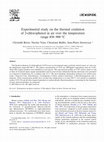Papers by Christelle Briois

Polyoxymethylene (POM : -(CH2 -O)n-) has been proposed as a parent compound to explain the densit... more Polyoxymethylene (POM : -(CH2 -O)n-) has been proposed as a parent compound to explain the density profile of formaldehyde (H2 CO) in comets. Indeed the production rate of H2 CO cannot be interpreted by its direct sublimation from nucleus ices. It shows a distributed source. However, the thermal degradation of POM in the solid state on grains ejected from the nucleus is a consistent scenario to adjust observations and modeling of the chemistry of formaldehyde in cometary atmosphere (Cottin et al, 2004; Fray et al, 2006). Nevertheless POM has never been detected in a comet. Infrared and visible spectroscopies are useless for its detection: for instance it shows the same spectral feature than the silicates at 10µm (Vanysek & Wickramasinghe, 1975). In addition to being a good candidate as a parent compound for the distributed source of H2 CO, POM can be synthesized during UV photolysis and thermal process of interstellar or cometary laboratory ice analogs (Bernstein et al., 1995; Shutte et al., 1993a, 1993b). Therefore polyoxymethylene is a key compound to be looked for with the ROSETTA instruments. COSIMA (Cometary Secondary Ion Mass Analyser) is a time of flight secondary ion mass spec-trometer (TOF SIMS), onboard the Rosetta spacecraft. COSIMA will analyze cometary grains in order to determine their elemental, isotopic and molecular composition. The cometary grains will be collected on metallic targets exposed to the dust tail (Kissel et al, 2007). In this presen-tation, we will discuss the extent to which COSIMA will be able to detect polyoxymethylene. We will study this question by measuring the mass spectrum of POM using a ground analog of COSIMA, and by modeling the lifetime of this polymer on cometary grains collected on metallic target. References : Cottin H. et al. (2004) Icarus 167, 397-416 ; Fray N. et al. (2006) Icarus 184, 239-254 ; Vanysek V. & Wickramasinghe N.C. (1975) Astrophys. Space Sci. 33, L19-L28; Bernstein M.P. et al (1995) ApJ 454, 327-344 ; Shutte W.A. et al. (1993a) Science 259, 1143-1145 ; Shutte W.A. et al. (1993b) Icarus 104, 118-137 ; Kissel J. et al. (2007) Space Sci. Rev. 128, 823-867

The European Rosetta spacecraft launched on March 2004 will reach the comet 67/P-Churyumov-Gerasi... more The European Rosetta spacecraft launched on March 2004 will reach the comet 67/P-Churyumov-Gerasimenko in 2014 to perform the most exhaustive study ever achieved on comets (Glassmeier et al. 2007). The COmetary Secondary Ion Mass Analyser (COSIMA) carried on board will focus on chemical analysis of cometary dust grains collected in situ on a variety of metallic targets. COSIMA's goals are the in-situ characterisation of the atomic, molecular and isotopic composition of cometary dust grains. These analyses will provide inorganic and organic data about pristine solar system material (Kissel et al. 2007). COSIMA is a time-of-flight secondary ion mass spectrometer (TOF-SIMS) using an indium liquid metal ion source. Spectra inter-pretation of complex unknown samples with COSIMA instrument will be difficult due to the limited mass resolution (M/M of 2000 at m=100 amu) which excludes unambiguous compounds identification and requires preliminary work with reference samples. To help the interpretation of COSIMA spectra calibration laboratory work is in progress using the twin of the COSIMA flight instrument located at Katlenburg-Lindau (Germany) and the prototype of COSIMA in Orléans (France). Here we report the analysis of 100-400m deposits of organics performed with the COSIMA prototype based in Orléans. The organics are expected to be minor peaks, making their identification not simple. Nucleobase molecules, especially the purine bases, are among the building of the replicating molecules of life (DNA and RNA). Scour the universe in an attempt to find such a natural source of nucleobases is of fundamental significance in considerations of the origin of life (Lazcano Miller 1996) Therefore we focused our work on N-heterocyclic compounds which are believed to be present in comets or which belong to the chemical family of such molecules (Krueger Kissel 2006). Experiments have been performed on nine compounds: adenine, guanine, imidazole, 2-aminopyrimidine, cytosine, isocytosine, thymine, 4-aminopyrimidine and uracil. The first step was to characterize all these pure ni-trogenous organic molecules by their high statistics of positive and negative spectra. Deep examination has then been performed to look for peculiarity: we tried to differentiate i) the fragmentation peaks of a complex molecule from the quasi-molecular peak of pure compounds at the same mass and ii) characteristic features between isomers. For almost all compounds, highly intensive parent-like secondary ions of the general composition [M+H]+ or [M-H]-and characteristically large fragment ions correlated with functional groups were emitted. None possible ambiguities were revealed between the peaks from the actual molecule and the same one in a substructure form: they have two different spectral features. The two molecules were even distinguishable in binary mixture experiments. References: Glassmeier KH et al. (2007) Space Sci. Rev. 128, 1-21. Kissel J et al. (2007) Space Sci. Rev. 128, 823-867 Lazcano A Miller S.L. (1996) Cell 85, 793-798 Krueger F.R. Kissel J. (2006) Eds Springer, p 325-339

The Rosetta mission launched by ESA in March 2004 will reach the comet 67P/Churyumov-Gerasimenko ... more The Rosetta mission launched by ESA in March 2004 will reach the comet 67P/Churyumov-Gerasimenko in 2014 to perform the most exhaustive study ever achieved on comets. A time-of-flight secondary ion mass spectrometer (TOF-SIMS), named COSIMA (COmetary Secondary Ion Mass Analyser), is onboard the Rosetta spacecraft. It will focus on chemical analysis of solid cometary grains collected in situ. COSIMA is one of the most promising instrument in the payload of Rosetta to identify the refractory organic molecules present on comet. Here, we focus on the detection of a specific compound: the polyoxymethylene (POM: -(CH2-O)n-). Indeed POM could be at the origin of the distributed source of formaldehyde in several comets. Moreover it is produced during the irradiation and/or thermal treatment of cometary ice analogs. It could also have played an important role in the sugar synthesis on the primordial Earth: it is a very concentrated source of formaldehyde. We will discuss the extent to which COSIMA will be able to detect polyoxymethylene. The mass spectrum of POM has been measured using a ground analog of COSIMA, and we have calculated the lifetime of this polymer on cometary grains collected by COSIMA.
We were focusing on using a new UV laser ion desorption source combined with a SIMS laboratory ti... more We were focusing on using a new UV laser ion desorption source combined with a SIMS laboratory time-of-flight mass spectrometer, the latter being very similar to the COSIMA flight instrument onboard Rosetta.

Chemosphere, 1999
The thermal degradation processes of chlorobenzene were investigated using a tubular flow reactor... more The thermal degradation processes of chlorobenzene were investigated using a tubular flow reactor at I atm. over the range 575–825°C in reaction atmospheres in which oxygen was in excess (equivalence ratio Φ = 0.035). The concentration profiles of C6H5Cl, C02, HCl and Cl2 as well as the major intermediate byproducts (CO, CH4 C2H2 C2H4 vinyl chloride, vinylacetylene, furane and benzene) were determined as a function of temperature for a residence time of 2 seconds. More seventy organics as trace species were also identified. Most of them are aromatics substituted by Cl (1 to 4), OH (1 or 2) or alkyl groups. Some precursors of dioxins ( benzofuranes and chlorophenols) were also observed. Experimental results showed that the ring breaking processes were preponderant over the studied temperature range. Reaction pathways explaining the formation of mainly observed products are presented and discussed.

Chemosphere, 2006
The thermal oxidation of 2-chlorophenol (2-CP) in air was investigated using a perfectly stirred ... more The thermal oxidation of 2-chlorophenol (2-CP) in air was investigated using a perfectly stirred reactor at 1 atm over the temperature range 450–900 °C. The relative concentration of 2-CP was 1000 ppmV (equivalence ratio Φ = 0.03). About fifty organic products were identified as trace species. The concentration profiles of 2-CP, carbon oxides as well as those of seventeen major organic intermediates and six non-to-lower chlorinated dioxins and furans were presented as a function of temperature for a residence time of 2 s. The most abundant intermediate products were carbon monoxide, 2 H-pyran-2-one, chlorobenzene, 4-cyclopenten-1,3-dione, phenol, benzofuran, 2-chlorohydroquinone and 2-indanone. These concentration profiles have revealed that temperatures of at least 900 °C were needed to completely oxidize 2-CP, CO and all other organic byproducts to carbon dioxide. Reaction pathways accounting for the formation of most observed products are proposed.
Environmental Science & Technology, 2007










Uploads
Papers by Christelle Briois